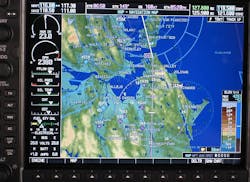DARPA eyes photonic integrated circuits for non-GPS position, navigation, and timing (PNT)
Officials of the Defense Advanced Research Projects Agency (DARPA) in Arlington, Va., issued a solicitation late last month for the Atomic-Photonic Integration (A-PhI) project that seeks to reduce the complexity of trapped-atom high-performance PNT devices.
This project also seeks to develop a trapped-atom gyroscope -- a matter-wave analogue of the interferometric fiber-optic gyroscope (FOG).
Reliable PNT is a critical resource for all U.S. military missions, and influences areas such as communications, navigation, reconnaissance, and electronic warfare (EW), DARPA officials explain.
PNT information typically comes from GPS navigation satellites, yet these signals are vulnerable to enemy jamming and disruption, which makes a backup to GPS essential. Clocks and inertial measurement units (IMUs) can provide GPS-like accuracy, but only for short periods. This is where the A-PhI project comes in.
DARPA researchers envision photonic integrated circuits as replacing the optical assembly behind atomic physics devices, while still enabling the necessary trapping, cooling, manipulation, and interrogation of atoms.
Atomic systems are the basis for the most sensitive and accurate angle sensors and clocks ever, yet these devices typically are heavy, bulky, and complex. DARPA wants to make trapped atoms portable while maintaining their accuracy.
Scientists in the past have tried to miniaturized this technology by removing optical elements, miniaturizing the remaining elements, and then tightly integrating them in a small package, but this approach has led to degraded performance and vulnerability to environmental conditions and design errors.
Photonic integrated circuits are considered promising because they can replace optical systems with readily-manufacturable and low-cost chips that have none of the alignment sensitivity of conventional free-space optics.
The A-PhI project aims to demonstrate that compact photonic integrated circuits can replace the optical bench of conventional free-space optics for high-performance trapped-atom gyroscopes and trapped-atom clocks without degrading the performance of the underlying package.
Related: Three companies set sights on precision navigation that works independently of GPS
The project also will also demonstrate proof-of-concept trapped-atom gyroscopes that will lead not only lead to an unprecedented reduction in system size, but also generate an order of magnitude improvement in angular sensitivity and dynamic range over its free-space predecessor.
The A-PhI project focuses on two technical areas: developing a photonic integrated clock prototype; and developing a trapped-atom gyroscope based on a Sagnac interferometer architecture.
Companies interested should submit abstracts no later than 16 Aug. 2018, and full proposals no later than 27 Sept. 2018 to the DARPA BAA Website at https://baa.darpa.mil.
Email questions or concerns to DARPA's John Burke at [email protected]. More information is online at https://www.fbo.gov/spg/ODA/DARPA/CMO/HR001118S0053/listing.html.
Ready to make a purchase? Search the Military & Aerospace Electronics Buyer's Guide for companies, new products, press releases, and videos
